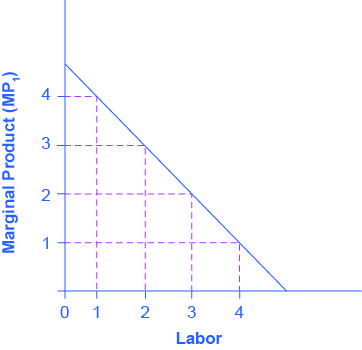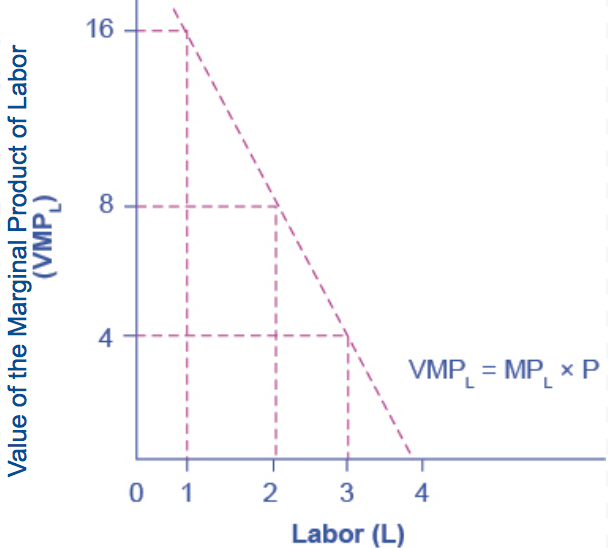4.6 – Labour Markets
Learning Objectives
- Describe labour markets; explain why the value of the marginal product of labour is the demand for labour
What is the labour market?
The labour market is the term that economists use for all the different markets for labour. There is no single labour market. Rather, there is a different market for every different type of labour. Labour differs by type of work (e.g. retail sales vs. scientist), skill level (entry level or more experienced), and geographic location (the market for administrative assistants is probably more local or regional than the market for university presidents). While each labour market is different, they all tend to respond to similar disturbances in similar ways. For example, when wages go up for one type of job in an industry, they tend to go up in other types of jobs too. When economists talk about the labour market, they are describing these similarities.
The labour market, like all markets, has a demand and a supply. Why do firms demand labour? Why is an employer willing to pay you for your work? It’s not because the employer likes you or is socially conscious. Rather, it’s because your labour is worth something to the employer–your work brings in revenues to the firm. How much is an employer willing to pay? That depends on the skills and experience you bring to the firm.
If a firm wants to maximize profits, it will never pay more (in terms of wages and benefits) for a worker than the value of his or her marginal productivity to the firm. We call this the first rule of labour markets.
Suppose a worker can produce two widgets per hour and the firm can sell each widget for $4 each. Then the worker is generating $8 per hour in revenues to the firm, and a profit-maximizing employer will pay the worker up to, but no more than, $8 per hour, because that is what the worker is worth to the firm.
Recall the definition of marginal product. Marginal product is the additional output a firm can produce by adding one more worker to the production process. Since employers often hire labour by the hour, we’ll define marginal product as the additional output the firm produces by adding one more worker hour to the production process. In this module, we assume that workers are homogeneous—they have the same background, experience and skills and they put in the same amount of effort. Thus, marginal product depends on the capital and technology with which workers have to work.
A typist can type more pages per hour with an electric typewriter than a manual typewriter, and he or she can type even more pages per hour with a personal computer and word processing software. A ditch digger can dig more cubic feet of dirt in an hour with a backhoe than with at shovel.
We can define the demand for labour as the marginal product of labour times the value of that output to the firm.
| # Workers (L) | 1 | 2 | 3 | 4 |
|---|---|---|---|---|
| MPL | 4 | 3 | 2 | 1 |

On what does the value of each worker’s marginal product depend? If we assume that the employer sells its output in a perfectly competitive market, the value of each worker’s output will be the market price of the product. Thus:
[latex]{\scriptsize \begin{equation} \text{Demand for Labour} = \text{MP}_L \times \text{P} = \text{Value of the Marginal Product of Labour}\end{equation}\scriptsize}[/latex].
We show this in Table 2, which is an expanded version of Table 1.
| # Workers (L) | 1 | 2 | 3 | 4 |
|---|---|---|---|---|
| MPL | 4 | 3 | 2 | 1 |
| Price of Output | $4 | $4 | $4 | $4 |
| VMPL | $16 | $12 | $8 | $4 |
Note that the value of each additional worker is less than the ones who came before.
Thus, the demand for labour (that is, the value of the marginal product of labour is downward sloping as the firm hires additional labour.

Watch It!
The video The Marginal Product of Labour takes us through the example of a restaurant interested in hiring janitors. With clean facilities, a restaurant will make more money, but they must consider the cost of a janitor versus the benefit from their labour. Watch the selected clip from this video to see how this correlates to a supply and demand graph.
Watch The marginal product of labor (10 mins) on YouTube
Video Source: Marginal Revolution University. (2015, April 7). The marginal product of labor [Video]. YouTube. https://youtu.be/G7ai5LAehqg. Licensed under CC BY-ND 4.0.
Try It
Try It (Text Version)
- Which of the following is correct concerning labour markets?
- Labour markets lack the supply and demand economic model.
- Labour differs by type of work.
- There is one type of labour market.
- The demand for labour is the price of output multiplied by the marginal product of labour which is also the ________.
- value of the marginal product of labour
- minimum marginal product of labour
- maximum marginal product of labour
Check your Answers: [1]
Activity source: "Labor Markets" In Microeconomics by Lumen Learning, licensed under CC BY 4.0. / Converted to H5P and text.
Try It
Try it 2 (Text version)
- The table below shows data for the production of Pineapples for an individual firm. Given this data, what is the marginal product of labour when quantity increases from 2 by one unit?
Workers vs Pineapple Production Number of workers Number of Pineapples 0 0 1 10 2 18 3 24 4 28 5 30 - The table below shows data for the production of Bags for an individual firm. Given this data, what is marginal product of labour when quantity increases from 10 by ten units? Hint: Marginal product is the additional output of one more worker. Mathematically, Marginal product is the change in total output divided by the change in labour
Workers vs Bag production Number of workers Number of Bags 0 0 10 20 20 36 30 48 40 56 50 60 - The table below shows data for the production of Jackets for an individual firm operating in a perfectly competitive market. Suppose that the price of Jackets is $3. Given this data, calculate the Marginal Product of Labour (MPL) and the Value of the Marginal Product of Labour (VMPL) if the quantity of output was 30 jackets.
Workers vs. Jacket production Number of workers Number of Jackets 0 0 10 80 20 144 30 192 40 224 50 240
Hint: Marginal product is the additional output of one more worker. Mathematically, Marginal product is the change in total output divided by the change in labour. [latex]{\scriptsize \begin{equation} \text{VMP}_L = \text{MP}_L \times \text{P}\end{equation}\scriptsize}[/latex]
Check your Answers: [2]
Activity source: "Labor Markets" In Microeconomics by Lumen Learning, licensed under CC BY 4.0. / Converted to H5P and text.
Attribution
Except where otherwise noted, this chapter is adapted from "Labor Markets" In Microeconomics by Lumen Learning, licensed under CC BY 4.0. A derivative of "The Theory of Labor Markets" In Principles of Economics 2e by Steven A. Greenlaw & David Shapiro (OpenStax), licensed under CC BY 4.0.
Access for free at Principles of Economics 2e
Media Attributions
- Marginal Product of Labor © Steven A. Greenlaw & David Shapiro (OpenStax) is licensed under a CC BY (Attribution) license
- Value of the Marginal Product of Labor © Steven A. Greenlaw & David Shapiro (OpenStax) is licensed under a CC BY (Attribution) license
- Question 1. b) For example, retail sales, educators, and scientists. Question 2. a) The demand for labour, that is, the value of the marginal product of labour is downward sloping as the firm hires additional labour. For firms operating in a competitive output market, the value of additional output sold is the price the firms receive for the output. Since MPL declines with additional labour employed, while that marginal product is worth the market price, the value of the marginal product declines as employment increases. ↵
- Question 1) 6. Question 2) 1.6 Question 3) MPL = 4.8, VMPL=14.4 ↵
an employer will never pay a worker more than the value of the worker’s marginal productivity to the firm
the marginal product of an additional worker multiplied by the price of the firm’s output

